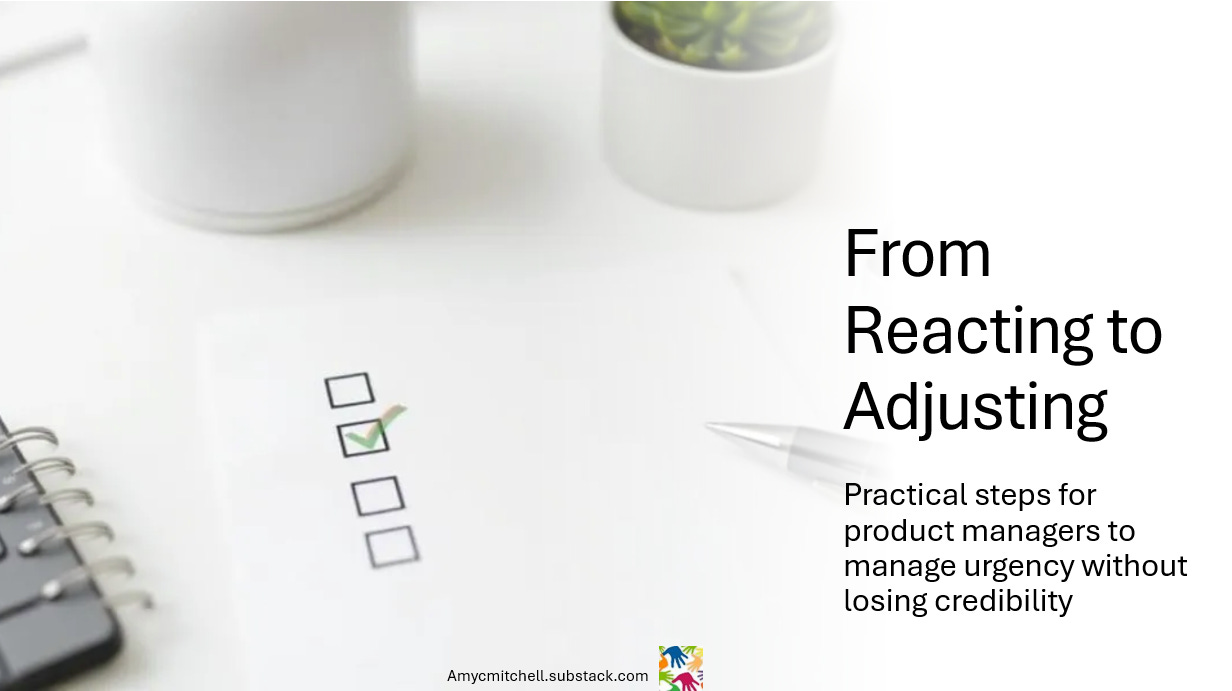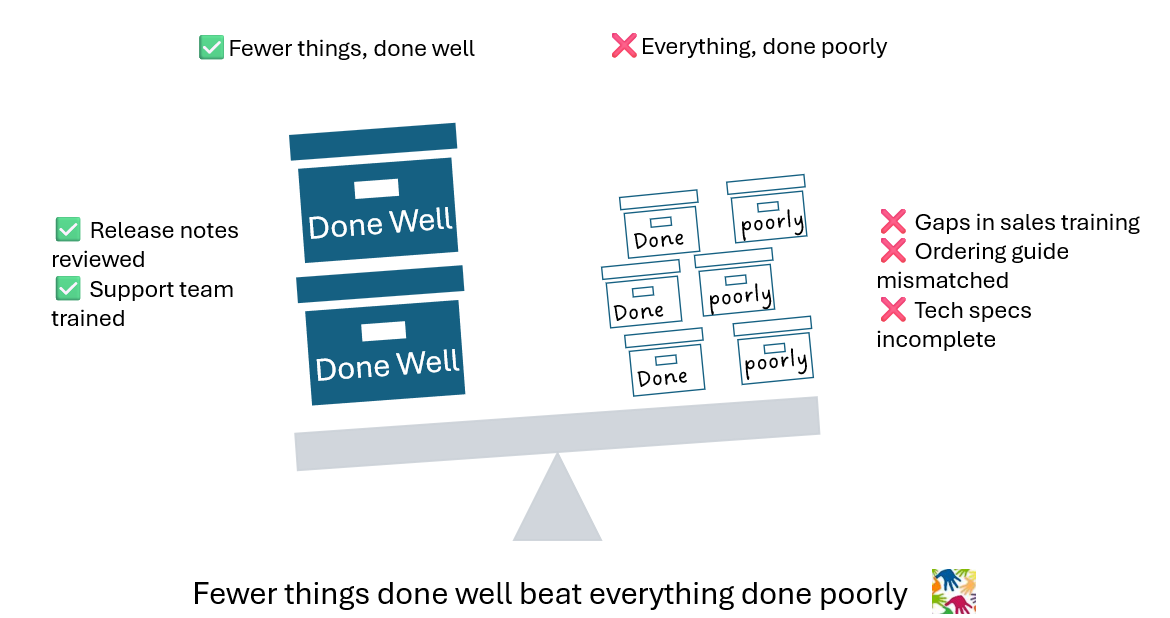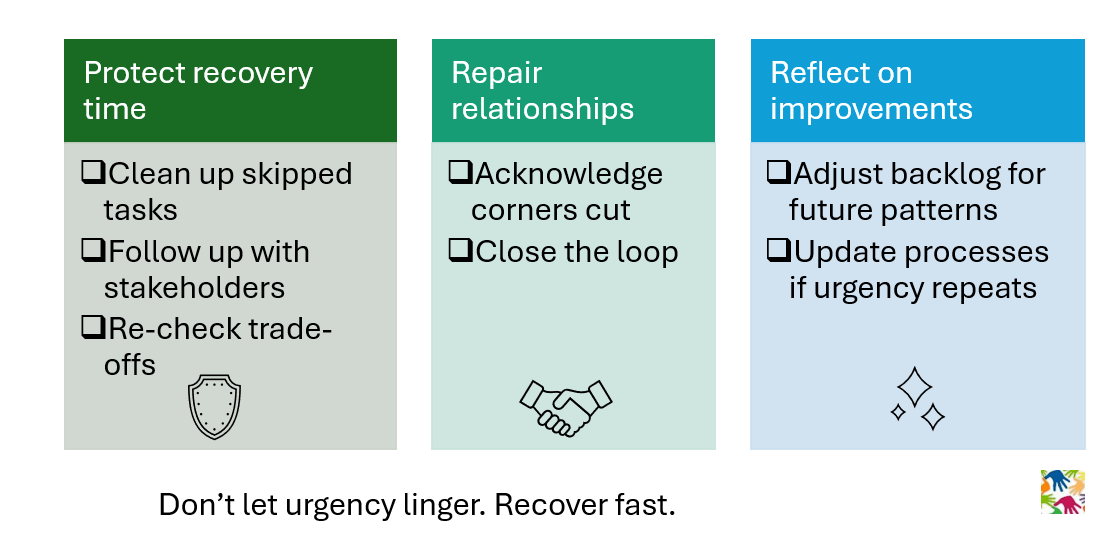From Reacting to Adjusting
Practical steps for product managers to manage urgency without losing quality or credibility
“We need this by the end of the month.”
That’s how Gerry learned her “minor” initiative was suddenly part of an end-of-year sales push. The request came out of nowhere—just days before her vacation.
Gerry rushed to finish everything. In the scramble she made mistakes, forgot to loop in stakeholders, and didn’t flag trade-offs to her manager. She even kept juggling her other projects at the same time.
By the end, she delivered—but at the cost of relationships, credibility, and clean-up work for her teammates.
This scenario is all too familiar. Urgent requests hit product managers often. The real test isn’t whether urgency happens. It’s how you respond when it does.
Most product managers will recognize themselves in Gerry. It’s not about whether urgency strikes — it will. The test is how you adjust without letting pressure unravel months of progress.
This article gives you steps to adjust when you face this situation:
Adjusting instead of reacting
Executing through the urgency
Recovering after the storm
Adjusting Instead of Reacting
Just because something is urgent doesn’t mean you dive in headfirst. Pause. Absorb the impact. Then apply your product manager toolkit: prioritize, communicate, collaborate, protect relationships.
The hardest moment isn’t the work itself — it’s that split-second between getting the urgent request and deciding how to respond. That’s where product managers are in control.
Three quick adjustments:
1. Re-scope fast
Drop or delay what matters least. Clear space to focus on the urgent request.
Common mistake: Product managers try to keep everything alive. In reality, you earn more trust by dropping something visibly and deliberately
2. Re-communicate priorities
Tell stakeholders what’s shifting and why. Don’t leave them guessing. A short note with “what changed, what didn’t, when more info is coming” is often enough.
3. Re-calibrate with your manager
Even if the request came from your manager, send a quick impact update: what you’re emphasizing, what’s delayed, and who’s involved. Remember: you track priorities more closely than your boss.
How It Looks in Practice:
Drop non-critical items immediately
Tell teams the new plan and timing
Ping your manager with the quick impact summary
Executing Through the Urgency
Once you’ve adjusted, the real work begins. Urgency doesn’t mean ‘anything goes’. It means the essentials matter more than ever.
4 steps to focus on the essentials:
1. Preserve quality over volume
Deliver fewer things well. Sloppy work multiplies delays for everyone.
2. Re-order communication
Use direct, short updates. Focus on teams and stakeholders directly impacted.
3. Pull in allies
Enlist cross-functional partners who already know the context. Give them the “why” so they can help adjust smoothly.
4. Surface trade-offs
Keep a running list of what’s being dropped or delayed. Say the risks out loud.
How It Looks in Practice:
Ship the minimum viable acceleration with normal quality
Tell teams what to expect (even if full updates come later)
Enlist allies to help spread updates
Share the list of trade-offs openly
Recovering After the Storm
Urgency is temporary. But if you don’t recover well, the damage can linger longer than the fire drill itself. Steps to recover:
1. Protect recovery time
Clean up skipped tasks, close loops, and revisit trade-offs.
2. Repair relationships
Acknowledge where you cut corners. Reconnect with stakeholders you pulled back from.
Don’t overcomplicate this. A quick message like ‘Thanks for flexing with us — here’s where we landed’ goes a long way.
3. Reflect on improvements
If urgent requests are common, adjust your process or backlog so you’re not blindsided again.
How It Looks in Practice:
Correct rushed mistakes
Check in with affected teams to set recovery steps
Reframe your future approach: prioritize minimum requirements first, “nice-to-haves” later
The Takeaway
For product managers, urgency moments are more than fire drills — they’re leadership auditions. Each time you adjust instead of react, you prove that pressure won’t shake your judgment. That’s how credibility compounds.
Your playbook:
Pause and re-scope, re-communicate, re-calibrate
Execute with quality, allies, and visible trade-offs
Recover by cleaning up, reconnecting, and reflecting
Having this plan ready means the next surprise won’t break you—or your relationships.
That’s how product managers turn urgency into credibility.
Subscriber bonus: The Urgency Checklist
Save this one-page checklist so the next time urgency hits, you don’t have to think
Looking for more practical tips to improve your product management skills?
Free Product Manager Resources from Product Management IRL
Premium Product Manager Resources (paid only) 3 learning paths, 6 product management templates and 7 quick starts. New items monthly!
TLDR Product listed Product Management IRL articles recently! This biweekly email provides a consolidated list of recent product management articles.
Sponsored by The Deep View
Connect with Amy on LinkedIn, Threads, Instagram, and Bluesky for product management insights daily.








awesome